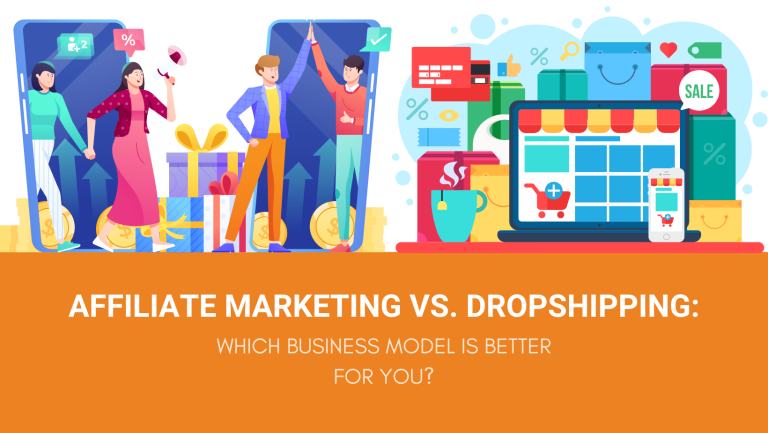If you’re interested in passive income opportunities, for sure you’ve heard the endless debate of affiliate marketing vs. dropshipping.
Both of these business models are great ways to earn money online without worrying about product inventory.
But you probably read tons of opinions out there firmly standing behind one or the other. So, what is it? Is it more profitable to have an affiliate marketing business or sell products on eCommerce stores?
This in-depth comparison guide to choosing between affiliate marketing and dropshipping will help you decide.
What Is Affiliate Marketing?

Affiliate marketing is a popular passive income strategy where you earn commissions by promoting other companies’ products or services.
It’s a performance-based model—you get paid only when someone makes a purchase through your unique affiliate link.
Here’s how it works:
- Join an affiliate program (e.g., Amazon Associates, Shopify Affiliate, or niche-specific programs).
- Get a unique affiliate link to track referrals.
- Promote the product via your blog, website, YouTube channel, or social media.
- Earn commissions when someone clicks your link and makes a purchase.
Affiliate tracking relies on cookies, which store data when a user clicks your link. These cookies can last anywhere from 7 to 45 days, meaning you can still earn a commission if the buyer makes a purchase within that time frame—unless they clear their cookies or use a different device.
Unlike dropshipping, affiliate marketing doesn’t involve customer service, product sourcing, or fulfillment, making it a hands-off way to generate income. However, success depends on driving traffic and building a trusted audience that converts.
What Is Dropshipping?

Dropshipping is an eCommerce business model where you sell products online without stocking inventory or handling fulfillment. Instead, when a customer places an order on your store, you purchase the item from a third-party supplier, who then ships it directly to the buyer.
The key difference between dropshipping and traditional retail is that you don’t buy products upfront.
Regular retailers purchase stock in bulk and store it in warehouses, taking on inventory risks. With dropshipping, you only pay for a product after you’ve made a sale, making it a low-risk, low-investment way to start an online business.
The process is simple:
- Find a product from a supplier and add it to your online store.
- Market your store to attract customers.
- Receive an order, then purchase the product from your supplier.
- The supplier ships the item directly to the customer.
Dropshipping is an accessible entry point into eCommerce, but like any business model, it comes with its own challenges, such as supplier reliability, profit margins, and competition.
Pros and Cons of Affiliate Marketing
Affiliate marketing is a great way to earn passive income, but like any business model, it comes with advantages and challenges. Here’s a breakdown:
Pros of Affiliate Marketing
- Low Startup Costs – No need to invest in inventory, storage, or product development. You just need a website, blog, or social media presence.
- No Customer Service Hassles – You don’t handle refunds, shipping, or complaints—the merchant takes care of everything.
- Passive Income Potential – Once your content ranks or gains traction, you can earn commissions on autopilot.
- Wide Variety of Products to Promote – You can be an affiliate for almost anything, from software and digital courses to physical products on Amazon.
- Flexible & Scalable – Work from anywhere, and scale your earnings by increasing traffic and optimizing conversions.
Cons of Affiliate Marketing
- Dependence on Merchant Policies – Commission rates, cookie durations, and program rules can change anytime, reducing your earnings.
- Intense Competition – Many niches are saturated, making it harder to rank on search engines and drive traffic.
- No Control Over Product or Pricing – You’re promoting someone else’s products, so you can’t adjust pricing, offer discounts, or improve product quality.
- Income Instability – Earnings depend on traffic and conversions. A decline in website visitors or changes in an affiliate program can impact income.
- Delayed Payments – Many affiliate programs have payout thresholds and waiting periods (e.g., 30-60 days after a sale), delaying your earnings.
Pros and Cons of Dropshipping
Dropshipping is a popular eCommerce model, but it has its advantages and drawbacks. Here’s what you need to know before diving in:
Pros of Dropshipping
- Low Upfront Investment – You don’t need to buy inventory in advance, making it a low-risk way to start an online store.
- No Need for Warehousing or Logistics – Your supplier handles storage, packaging, and shipping, saving you time and costs.
- Wide Product Variety – Since you don’t hold inventory, you can test and sell different products without commitment.
- Scalable Business Model – As long as you have reliable suppliers, you can expand your store and reach more customers without the hassle of fulfillment.
- Location Independence – You can run a dropshipping business from anywhere with an internet connection.
Cons of Dropshipping
- Thin Profit Margins – Many dropshipping products are highly competitive, leading to lower markups and profits.
- Supplier Reliability Issues – You depend on third-party suppliers for product quality, stock availability, and shipping speed, which can sometimes lead to delays or issues.
- Customer Service Responsibilities – Even though you don’t handle shipping, you’re still responsible for resolving customer complaints, returns, and chargebacks.
- Shipping Times Can Be Long – If sourcing from overseas suppliers (e.g., AliExpress), delivery times can take weeks, leading to unhappy customers.
- Branding Limitations – Since you’re selling generic supplier products, it’s harder to build a unique brand unless you use private labeling.
Dropshipping vs. Affiliate: Side-By-Side Table Comparison
Let’s take a look at this visual comparison chart of affiliate marketing vs. dropshipping features:
| Features | Affiliate Marketing | Dropshipping |
| Point-of-Sale | Affiliate website | Your online store |
| Customer Service | No | Yes |
| Cost of Entry | Low | Low |
| Earnings Model | Fixed commission | Arbitrage |
| Growth Potential | Medium | High |
| Website/Store | Optional | Yes |
| Inventory Storage | No | No |
| Order Processing | No | Yes |
| Business Control | Low | High |
| Customer Data | No | Yes |
| Repeat Sales | No | Yes |
Affiliate Marketing vs. Dropshipping: Features Comparison
Now that we’ve quickly glanced over all the pros and cons of both affiliate marketing and dropshipping, it’s time to take a deeper look into each feature individually.
Products Sold

The main difference between affiliate marketing and dropshipping is in the products sold.
Although the dropshipping products are still not yours (they’re typically warehoused and shipped out by your supplier or dropshipping agent), you’re still selling them on your eCommerce store.
On the other hand, affiliate marketers don’t technically sell anything – the sale occurs on the actual product website.
They just promote a service or product link on their blog, podcast, or influencer profile, and they earn a commission from every sale.
Time to Launch

If you already have a well-ranked blog or a strong social media presence, launching an affiliate marketing business can be relatively quick.
You simply sign up for affiliate programs, get your unique tracking links, and strategically place them on high-traffic content. Influencers can also leverage their existing audience to drive affiliate sales with minimal effort.
However, if you’re starting from scratch, affiliate marketing can take time. Building a blog, ranking on search engines, and growing a loyal audience require consistent effort, and results aren’t immediate.
Dropshipping, on the other hand, offers a faster path to making sales. Since you control the online store, you can start running paid ads immediately after launching.
You don’t need to wait for organic traffic—you can drive visitors to your store through Facebook Ads, Google Ads, or influencer partnerships.
All you need to start dropshipping is an online store, a product, and a reliable supplier.
Platforms like Shopify make it easy for beginners to set up a store quickly. Plus, working with a sourcing agent like NicheDropshipping can streamline product sourcing and fulfillment, helping you scale faster.
Involvement and Ease
In the beginning, both affiliate marketing and dropshipping will require active involvement from your side.
But, generally speaking, dropshipping can be faster and easier to launch with just some minimal funds.
So, if you can get a basic Shopify account plus have some budget for ads, you can quickly start selling. Of course, given that you have a winning product and have done your research.
On the other hand, affiliate marketing requires writing blog posts or product reviews, making it far more time-consuming in the beginning.
However, affiliate marketing can become more of a passive income once you build solid organic traffic and many content pieces start ranking.
In affiliate marketing, you don’t have order fulfillment or customer service, so all you have to do is bring traffic.
Startup Costs

In theory, you can do both affiliate marketing and dropshipping with no money.
That’s because in dropshipping, you don’t pay for products upfront but only after you get an order. Plus, most affiliate programs are free to join.
However, this doesn’t mean that there aren’t any costs around these businesses.
The most common way affiliate marketing works is by blogging in a niche similar to the affiliate product you want to promote and incorporating your affiliate link within your article.
Another way is by doing product reviews or comparisons of the affiliate products.
So, unless you’re an influencer with a large social media following and can promote your product there, you will need a website for blogging.
And, of course, that means you’ll have to pay for a domain and website hosting.
If you don’t have the patience to write content and wait for your blog to start bringing organic traffic from search engine ranking, put some funds aside for paid ads.
In the case of dropshipping, the startup costs you’ll have are mainly for an online store.
The two most common eCommerce store builders are Shopify or WooCommerce and WordPress.
If you choose Shopify, their basic plan costs $19 a month.
On the other hand, WooCommerce is a free WordPress plugin. However, you’ll need a domain, hosting, and a bit of technical knowledge to set up your online store.
Earning Potential

We consider dropshipping to have a tremendous earning potential mainly because you can set your pricing and profit margins.
If you promote high-ticket product affiliate links, you can earn a lot from an affiliate marketing business as well, but you’ll have less control over your earnings.
Affiliate programs don’t offer a lot of space to scale since they set the commissions.
In short, in dropshipping, here’s how you earn:
selling price – wholesale price = profits
Regarding shipping costs, you can either deduct that or offer free shipping and put those expenses into the base product price.
In affiliate marketing, it goes like this:
percentage x selling price = profits
Of course, in both of these cases, we urge you to consider any other costs you have, such as paid ads, content writing services, etc.
Don’t forget to include these points in your calculations to get accurate results.
Control over Business
Dropshipping and eCommerce take the lead when it comes to having more control over your business and earnings. An online store is your own, and the profit margin of the products is set by you only.
On the other hand, all affiliate programs have their own fixed commissions that you can earn.
These vary in percentages, depending on the type of product you sell. So, you’ll always have less control and have to rely on someone else’s product and business.
Customer Service

Another difference between affiliate marketing and dropshipping is in how you manage customer support.
Customer service is vital for any online business model, but we suggest sticking with affiliate marketing if you don’t really like dealing with it.
When you sell products from different affiliate networks, they’re the ones dealing with customer support.
You only promote using an affiliate link that people will click on and earn a commission when they buy the product or service.
If you sell products through your online store, usually, you’re the one dealing with customer service.
Alternatively, contact a full-service dropshipping agent in China who provides different services, including customer support.
Growth Possibilities
There are cases of both affiliate marketers and dropshippers who made a big name for themselves in their niches.
These are, for instance, niche blogs that offer product reviews or comparisons that survive exclusively on affiliate commission.
However, generally speaking, it’s much easier to grow and scale your dropshipping business.
That’s mainly because in dropshipping, you can build a brand and a name for yourself. With this, you get to enjoy customer loyalty and repeat buyers.
Repeat Customers
Another area where dropshipping takes the lead is repeat purchases.
Unfortunately, affiliate marketing typically brings single purchases, as the reader buys a product once and then moves on to different content.
With dropshipping, on the other hand, you often have repeat customers, especially if you provide reliable shipping times and a good customer support experience.
But, also in dropshipping models, there’s a difference in customer loyalty. General dropshipping stores that sell something from everything find it more challenging to build a brand for themselves.
On the other hand, one-product stores that sell white-label or private-label products can enjoy greater loyalty and repeat purchases as it’s easier to up-sell and cross-sell.
Another problem that makes dropshipping better for repeat customers is that dropshippers typically have a list of their customers’ emails which they can use for retargeting campaigns or lookalike audiences.
Affiliate marketers usually don’t have their customers’ data since the point-of-sale occurs on another website.
Risks Involved

The good thing about affiliate marketing and dropshipping is that they’re both a low-risk business model. So, when deciding between dropshipping vs. affiliate, risks in terms of costs are minimal.
In terms of time vs. value, affiliate marketing is seemingly less risky if you already have a blog, but if you’re only now starting to post blogs and build a following, it can be time-consuming.
On the other hand, drop shipping uses mainly paid advertisement until you build a name and a following. However, you don’t have to wait for search engines to index you and your blogs to rank organically.
So, in terms of costs, we’d say drop shipping could be slightly more costly. However, in terms of time spent to launch, affiliate marketing takes more time if you don’t have the audience already.
FAQs on Affiliate Marketing vs. Dropshipping
Is Affiliate Marketing Worth It for Beginners?
Yes, affiliate marketing can be worth it for beginners, especially those with a blog, social media following, or an audience in a specific niche.
It requires minimal upfront investment, making it a low-risk way to start earning passive income.
However, results often take time, as success depends on generating consistent traffic and building trust with your audience.
What’s Better Between Affiliate Marketing vs Dropshipping vs Amazon?
Each business model has its pros and cons:
- Affiliate marketing is great for passive income but requires time to build an audience.
- Dropshipping allows you to sell physical products without holding inventory, but it requires managing customer service and handling supplier relationships.
- Amazon (FBA or affiliate) provides a massive marketplace but comes with high competition and fees.
The best option depends on your goals—affiliate marketing suits content creators, dropshipping works well for hands-on eCommerce entrepreneurs, and Amazon is ideal for those who want access to an established marketplace.
Can You Combine Affiliate Marketing and Dropshipping?
Yes, you can combine both. Many eCommerce store owners add affiliate links to their blogs to monetize traffic, while some affiliate marketers eventually transition into dropshipping to maximize profits. Using both can diversify income streams and create a more sustainable online business.
Is Amazon Affiliate the Same as Dropshipping?
No, Amazon’s affiliate program (Amazon Associates) is different from dropshipping. With Amazon affiliate marketing, you earn commissions by referring customers to Amazon, and they handle fulfillment.
In dropshipping, you sell products directly from suppliers and manage customer service, pricing, and branding. While both require minimal upfront investment, dropshipping gives you more control over pricing and profits.
Can You Do Dropshipping and Affiliate Marketing at the Same Time?
If you’re new at this, we recommend sticking to one thing at first. Starting a new business can be overwhelming as it is, so your whole focus should go to this one business that you decided on.
However, if you have some experience already, there’s no reason why you shouldn’t combine dropshipping and affiliate marketing. Many dropshippers do that successfully.
The best way to combine these two online business models is by having a blog p on your online store that you can use to post valuable content that would educate, help, or inform your readers.
Try to give value, don’t just sell your products in your blogs.
Then, find affiliate programs in your niche and seamlessly and naturally link their product to relevant keywords throughout your articles.
Suppose you’re an affiliate marketer already but want to test your success in dropshipping.
In that case, you could collaborate with a full-service dropshipping agent in China that can help you with your product sourcing and order fulfillment.
How Can I Start Affiliate Marketing with No Money?
To promote and bring sales, you need traffic. If you already have a running website, blogging is entirely free. However, for those that don’t have a website, that part isn’t free.
So, here are some free traffic sources to start affiliate marketing with no money:
- Organic Facebook engagement – create a group around your niche, join other groups, post valuable content and comments;
- YouTube – you could do product reviews, testing, or comparison videos for the affiliate products you’re promoting. Of course, don’t forget to place the affiliate link in the video description;
- Other social media – platforms like Instagram, Pinterest, Twitter, etc., can help you build an audience and connections. Many affiliate programs are digital and business-related, so even LinkedIn could be a great option;
How Can I Dropship without Money?

Dropshipping with no money sounds like something that many of us are eager to learn and explore.
Contrary to affiliate marketing, where you don’t necessarily need a website to work, dropshipping requires having an online store. And, this is the only part where a dropshipper has obligatory costs.
As we’ve mentioned before, Shopify’s basic plan costs $19 but comes with full service – domain and hosting included. But that’s not free.
The closest you can get to a free dropshipping store is to purchase a Bluehost hosting which costs from $3 to $6 and comes with an automatic and free WordPress installation.
Then, all you need is a domain. Usually, you can find domains on Bluehost, Hostgator, GoDaddy, etc. Their price depends on your choice. Once you have the domain, connect it and install the free WooCommerce plugin.
Then, choose a free theme and connect your store to free product supplier marketplaces like AliExpress, CJDropshipping, DHgate, etc., to import your first product listings.
WordPress has a lot of free plugins you can use to improve your WooCommerce store.
Although WordPress + WooCommerce seems cheaper, it will require some technical background and knowledge, while Shopify is more beginner-friendly.
How Much Can You Earn as an Affiliate Marketer?
Your earnings as an affiliate marketing depend a lot on the affiliate program you choose and on your promotion success.
For instance, affiliate networks that sell physical products typically don’t offer more than 5% commission.
However, affiliate marketing generally promotes digital products. These can have commission rates anywhere from 5 to 50%.
Furthermore, some affiliate networks offer recurring commissions if the buyer keeps using or renewing their product. These are excellent passive income strategies.
How Much Can You Earn as a Dropshipper?
As a drop shipper, we’d say there’s no cap on your earnings. We’d say a lot, but that depends on many factors. The possibility is there, but you have to play it smart.
Before launching your online store, make sure you have a winning product, a target audience, and have done your keyword research.
The greatest thing about dropshipping is that you are the one to decide the type of products you should sell and set the price markup. So, all the control in a dropshipping business model is in your hands.
On a Final Note
If we see affiliate marketing vs. dropshipping purely from the aspect of an online business model, they can both be profitable and lucrative when done right.
But, seeing long term and from a growth perspective, scaling your dropshipping business is much more likely than trying to grow as an affiliate marketer.
So, in terms of pure profitability, we believe drop shipping wins this battle.
We’d love to hear your thoughts! Do you have anything to add when it comes to affiliate marketing vs. dropshipping?
Still don’t know how to go around dropshipping? Send us a message so we can assist you.

